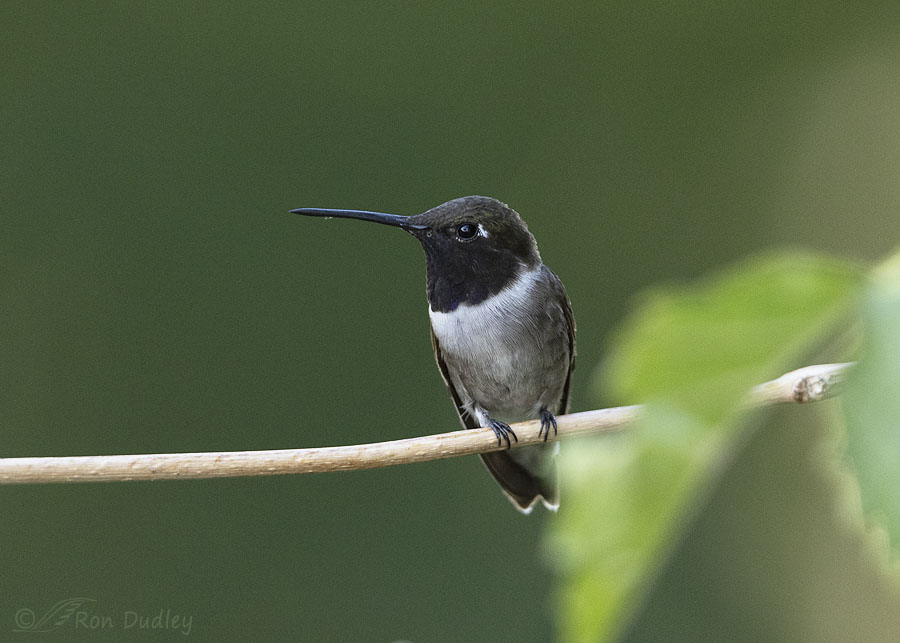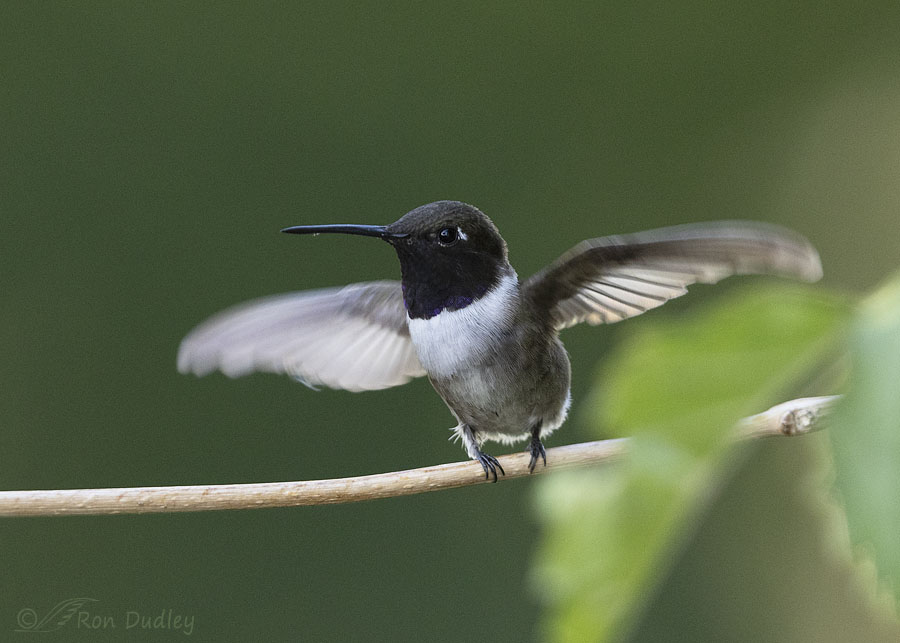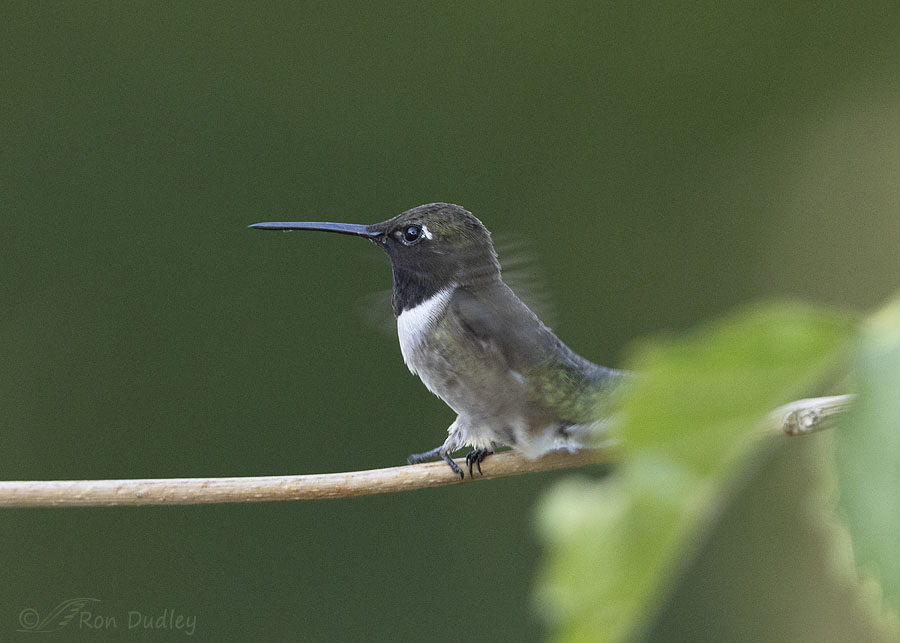Some bird photographers may see this effect to this degree more often than I do.
I’ve been sporadically photographing hummingbirds at my trumpet vine for about three weeks now but I’ve only seen one species, Black-chinned, and until recently I had only successfully photographed adult females and a single juvenile. The adult males have been spooky, elusive and downright maddening.
But five days ago one of the males got careless and allowed me a few perched shots of him. Those photos aren’t very good because he was in deep shade and there was annoying vegetation in the foreground. But the low light and resulting very slow shutter speed allowed me to see something I rarely if ever see to this degree in my photos.

1/500, f/5.6, ISO. 1600, Canon R5, Canon EF500mm f/4L IS II USM + 1.4 tc, not baited, set up or called in
It was early morning and the light was so low in the shade I only had a shutter speed of 1/500th of a second, even with my ISO cranked up to 1600. When he turned on his perch I fired off a quick burst. This photo and the following two are sequential without any skips.

1/500, f/5.6, ISO. 1600, Canon R5, Canon EF500mm f/4L IS II USM + 1.4 tc, not baited, set up or called in
When he started to turn on his perch he spread his wings and held them there for a split second before whirring his wings, lifting up from his perch and…

1/500, f/5.6, ISO. 1600, Canon R5, Canon EF500mm f/4L IS II USM + 1.4 tc, not baited, set up or called in
turning around in a flash.
When this shot was taken his wings were still whirring at or near full speed so at my very slow SS his wings essentially disappeared. All we see of his beating left wing is a few light-colored, blurry, nearly horizontal lines near his shoulder and throat.
Think about it. North American hummingbirds average around 53 wing beats per second and my SS was only 1/500th of a second, so those wings were doing a lot of traveling while my shutter was open.
Bird photographers who use slower super telephoto lenses than mine may see this effect to this degree more often than I do. But my fast lens, an f/4, usually allows me oodles of shutter speed, which I need because I have essential tremors which often causes my hands to shake and because I’m typically looking to take action shots.
Shaky hands and slow shutter speeds aren’t a good mix when you’re trying to photograph action. Or trying to freeze hummingbird wings.
Ron


I can never write so eloquently as your readers do as they have so much to add. I’ve enjoyed your blog for years. I’m 82 and my hands are not as steady as I wish but we have photoshop!!
Oh that last shot is SO cool!!!
Thanks, Kathleen.
Fascinating. On all counts – particularly as at the moment my VERY bad tremors in my hands and legs are being investigated (I struggle to turn the pages of a book at the moment). Like you I am messy and shake, which is a dangerous thing.
EC, I wish you all the luck in the world with what’s going on with you. Compared to what you’re enduring, my problem is very minor.
Nature in some of her many aspects in today’s post – birds, humans, visual and mental gymnastics. I echo Janis’ comment about FP being the first thing I open each AM – it always gives me something wonderful to think about (53 beats/sec – who knew essential tremors afflicted hummingbirds?!😊)
Thank you, Carolyn. If a hummer had tremors, can you imagine how fast it’s shaking would be… 🙂
I love this discussion and will try to apply what I have learned here to my attempts to photograph hummingbirds sitting in my lawn chair on my deck here in Boise. I have now identified a male, a female and a juvenile male black-chinned thanks to your recent pics. I have never seen more than one at the feeder and I have noticed that one chases another one away and I’m not sure who is shooing who away yet.
“I’m not sure who is shooing who away yet”
That’s hummers for you, Jo. It’s part of the fun of watching them. And the challenge of photographing them.
I’m glad you have photography and share it with us. Physical challenges can be limiting if you let them be so but they can also give us more reasons to find ways to enrich our lives. Unfortunately, I’ve known a few people who seem to have given up with far fewer challenges than I’ve had. You help us share Nature through your imagery and I hope that brings some measure of satisfaction to you as well. I know that teaching and experiencing the natural world with others is very rewarding for me even though it’s now in different ways than I could do before. Thanks for giving us a view of the world we don’t always get to see otherwise. (And, I may not have tremors but I can still do a good job of dribbling soup down my chin.)
Dan, knowing some of your recent health challenges I found your comment inspiring.
And I don’t “dribble” soup. Sometimes it flies all over the place!
Just want to say I love your work here on FP. I admire it all the more when I pause to consider the physical challenges you have had in your life. You inspire.
Thanks very much, Michael.
Glad this dapper chap cooperated for a few moments. Fascinating seeing the wings “disappear” like that.
I also rarely eat soup in public. No essential tremors, though — I’m just messy. 😉
Marty, I’m messy and have tremors. Another bad combination.
WOW! If you “didn’t know” you would wonder what the “weird stuff” was in the photo….. 😉 Endless patience and VERY fast reflexes required in these situations!
Appears the twig he’s sitting on is splitting the leaf on the right side of the shot or is that an illusion also?
I think that’s an illusion too, Judy. Looks to me like both leaves are in front of the twig.
Very interesting both in terms of photography and then the tremors. Thanks for including that. When I do meet people who have tremors I always think it is caused by early Parkinsons, so now I know it could be something else. Interesting too about your dad being a cabinet maker and having the same condition. I liked your comment too – I don’t eat soup in public. Good one.
And lastly, I think one of the marvels of nature is the speed of the hummingbird’s wings.
Everett, essential tremor is often familial (genetic). My paternal grandfather had it, as did my dad, his sister and one of my sisters. To my knowledge there was none of it on my mother’s side.
Wingbeats per second that a human can’t even begin to be able to count in that time period are just incomprehensible. It’s impressive to me what you’ve accomplished, given that you have essential tremor! After he developed essential tremor, my Dad found that he could still his hands and continue silversmithing jewelry by firmly bracing the bones of his lower forearms against the lip of his workbench. I SO ADMIRE you guys who can find ways to overcome obstacles !
GUYS WHO FIND A WAY !
Kris, many in my family had the tremors to some degree or another. My dad was a carpenter specializing in building cabinets so you can imagine his struggles with them. Like your dad, my dad found a way.
And no, I don’t eat soup in public… 🙂
i’m thinking about that, but my eyes are barely open and apparently my brain is not yet ready to ‘think about that’! I tried, and will try a bit later after coffee. Thank you for that information and photos, It truly is amazing!
I agree, Janis. Thinking pre-coffee can be a struggle – a struggle I often face in the early morning when I’m beginning to write the text for my blog posts.
But you know I’m so excited to see and read your posts it is the 1st thing I ‘open’ in the morning! Such a great way to begin my day!!
Here in Connecticut the males migrated south in late July and have entirely disappeared. The challenge I had when trying to photograph males was that if their gorgets directly reflected the sunlight they overexposed badly.
Kenneth, our males are still here but they sure are elusive.